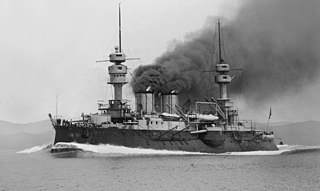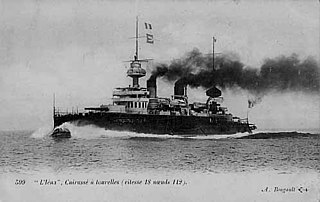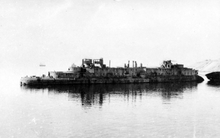
Bouvet was a pre-dreadnought battleship of the French Navy that was built in the 1890s. She was a member of a group of five broadly similar battleships, along with Charles Martel, Jauréguiberry, Carnot, and Masséna, which were ordered in response to the British Royal Sovereign class. Bouvet was the last vessel of the group to be built, and her design was based on that of Charles Martel. Like her half-sisters, she was armed with a main battery of two 305 mm (12 in) guns and two 274 mm (10.8 in) guns in individual turrets. She had a top speed of 18 knots, which made her one of the fastest battleships in the world at the time. Bouvet proved to be the most successful design of the five, and she was used as the basis for the subsequent Charlemagne class. Nevertheless, she suffered from design flaws that reduced her stability and contributed to her loss in 1915.

Suffren was a predreadnought battleship built for the Marine Nationale in the first decade of the twentieth century. Completed in 1902, the ship was assigned to the Escadre de la Méditerranée for most of her career and often served as a flagship. She had an eventful career as she twice collided with French ships and twice had propeller shafts break before the start of World War I in 1914. Suffren was assigned to join the naval operations off the Dardanelles, where she participated in a series of attacks on the Ottoman fortifications guarding the straits.

Bretagne was the lead ship of her class of three dreadnought battleships built in the 1910s for the French Navy. Bretagne entered service in February 1916, after the start of World War I. She spent the bulk of her nearly 25-year-long career with the Mediterranean Squadron and sometimes served as its flagship. During World War I she provided cover for the Otranto Barrage that blockaded the Austro-Hungarian Navy in the Adriatic Sea, but saw no action.

Jauréguiberry was a pre-dreadnought battleship constructed for the French Navy in the 1890s. Built in response to a naval expansion program of the British Royal Navy, she was one of a group of five roughly similar battleships, including Masséna, Bouvet, Carnot, and Charles Martel. Jauréguiberry was armed with a mixed battery of 305 mm (12 in), 274 mm (10.8 in) and 138 mm (5.4 in) guns. Constraints on displacement imposed by the French naval command produced a series of ships that were significantly inferior to their British counterparts, suffering from poor stability and a mixed armament that was difficult to control in combat conditions.

The Charlemagne class consisted of three pre-dreadnought battleships built for the French Navy in the 1890s. The ships spent most of their careers assigned to the Mediterranean Squadron. They had oddly eventful peacetime careers as they were involved in four accidental collisions between them, one of which sank a French submarine with all hands. Saint Louis was usually a fleet flagship during her career and Charlemagne twice participated in the occupation of the port of Mytilene on the island of Lesbos—then owned by the Ottoman Empire—once as part of a French expedition and another as part of an international squadron.

Iéna[je.na] was a pre-dreadnought battleship built for the French Navy. Completed in 1902 and named for one of Napoleon's victories, the ship was assigned to the Mediterranean Squadron and remained there for the duration of her career, frequently serving as a flagship. She participated in the annual fleet manoeuvres and made many visits to French ports in the Mediterranean. In 1907, while Iéna was docked for a refit, there was a magazine explosion that was probably caused by the decomposition of old Poudre B propellant. It killed 120 people and badly damaged the ship. Investigations were launched afterwards, and the ensuing scandal forced the Navy Minister to resign. While the damage could have been repaired, the obsolete ship was considered neither worth the time nor the expense; her salvaged hulk was used as a gunnery target in 1909, then sold for scrap in 1912.

Gaulois was one of three Charlemagne-class pre-dreadnought battleships built for the French Navy in the mid-1890s. Completed in 1899, she spent most of her career assigned to the Mediterranean Squadron. The ship accidentally rammed two other French warships early in her career, although neither was seriously damaged, nor was Gaulois.

Charlemagne was a predreadnought battleship built for the French Navy in the mid-1890s, the name ship of her class. Completed in 1899, she spent the bulk of her career in the Mediterranean Sea. The battleship was initially assigned to the Northern Squadron and was not transferred to the Mediterranean Squadron until 1900. Twice the ship participated in the occupation of the port of Mytilene on the island of Lesbos, then owned by the Ottoman Empire, once as part of a French expedition and another as part of an international squadron. Charlemagne and her sister ships rejoined the Northern Squadron in 1909 and the obsolete battleship became a gunnery training ship in 1913.

Saint Louis was the last of the three Charlemagne-class pre-dreadnought battleships built for the French Navy in the mid-1890s. She spent most of her career assigned to the Mediterranean Squadron and usually was chosen to serve as a flagship. The ship was involved in two accidental ramming incidents with two other French warships in her career, one of which sank a submarine.

Liberté was a pre-dreadnought battleship built for the French Navy in the mid-1900s. She was the lead ship of the Liberté class, which included three other vessels and was a derivative of the preceding République class, with the primary difference being the inclusion of a heavier secondary battery. Liberté carried a main battery of four 305-millimeter (12 in) guns, like the République, but mounted ten 194 mm (7.6 in) guns for her secondary armament in place of the 164 mm (6.5 in) guns of the earlier vessels. Like many late pre-dreadnought designs, Liberté was completed after the revolutionary British battleship HMS Dreadnought had entered service, rendering her obsolescent.

Vérité was a pre-dreadnought battleship built for the French Navy in the mid-1900s. She was the second member of the Liberté class, which included three other vessels and was a derivative of the preceding République class, with the primary difference being the inclusion of a heavier secondary battery. Vérité carried a main battery of four 305 mm (12 in) guns, like the République, but mounted ten 194 mm (7.6 in) guns for her secondary armament in place of the 164 mm (6.5 in) guns of the earlier vessels. Like many late pre-dreadnought designs, Vérité was completed after the revolutionary British battleship HMS Dreadnought had entered service and rendered her obsolescent.

Démocratie was a pre-dreadnought battleship built for the French Navy in the mid-1900s. She was the fourth member of the Liberté class, which included three other vessels and was a derivative of the preceding République class, with the primary difference being the inclusion of a heavier secondary battery. Démocratie carried a main battery of four 305 mm (12 in) guns, like the République, but mounted ten 194 mm (7.6 in) guns for her secondary armament in place of the 164 mm (6.5 in) guns of the earlier vessels. Like many late pre-dreadnought designs, Démocratie was completed after the revolutionary British battleship HMS Dreadnought had entered service, rendering her obsolescent.

République was a pre-dreadnought battleship, the lead vessel of the République class built for the French Navy built in the early 1900s. Laid down in December 1901, she was launched in September 1902 and commissioned in January 1907. Armed with a main battery of four 305 mm (12.0 in) guns, she was outclassed before even entering service by the revolutionary British battleship HMS Dreadnought, that had been commissioned the previous December and was armed with a battery of ten guns of the same caliber. Though built to an obsolescent design, République proved to be a workhorse of the French fleet, particularly during World War I.

Patrie was the second and final member of the République class of pre-dreadnought battleships of the French Navy built between her keel laying in April 1902 and her commissioning in July 1907. Armed with a main battery of four 305 mm (12.0 in) guns, she was outclassed before even entering service by the revolutionary British battleship HMS Dreadnought, that had been commissioned the previous December and was armed with a battery of ten guns of the same caliber. Though built to an obsolescent design, Patrie proved to be a workhorse of the French fleet, particularly during World War I.

The République class consisted of a pair of pre-dreadnought battleships—République, the lead ship, and Patrie—built for the French Navy in the early 1900s. They were ordered as part of a naval expansion program directed at countering German warship construction authorized by the German Naval Law of 1898. The French program called for six new battleships; the last four became the very similar Liberté class. République and Patrie, designed by Louis-Émile Bertin, were a significant improvement over previous French battleships. They carried a similar offensive armament of four 305 mm (12 in) guns and eighteen 164 mm (6.5 in) guns, though most of the 164 mm guns were now mounted in more flexible gun turrets rather than in casemates. They also had a much more effective armor protection arrangement that remedied the tendency of earlier battleships to lose stability from relatively minor damage.

Carnot was a pre-dreadnought battleship of the French Navy. She was laid down in July 1891, launched in July 1894, and completed in July 1897. She was a member of a group of five broadly similar battleships, along with Charles Martel, Jauréguiberry, Bouvet, and Masséna, which were ordered in response to the British Royal Sovereign class. Like her half-sisters, she was armed with a main battery of two 305 mm (12 in) guns and two 274 mm (10.8 in) guns in individual turrets. She had a top speed of 17.8 knots.

Charles Martel was a pre-dreadnought battleship of the French Navy built in the 1890s. Completed in 1897, she was a member of a group of five broadly similar battleships ordered as part of the French response to a major British naval construction program. The five ships were built to the same basic design parameters, though the individual architects were allowed to deviate from each other in other details. Like her half-sisters—Carnot, Jauréguiberry, Bouvet, and Masséna—she was armed with a main battery of two 305 mm (12 in) guns and two 274 mm (10.8 in) guns. The ship had a top speed of 18 knots.

Brennus was the first pre-dreadnought battleship built for the Marine Nationale. Completed in 1896, she was the sole member of her class, with a main battery of heavy guns mounted on the centerline and the first use of Belleville boilers. She formed the basis for several subsequent designs, beginning with Charles Martel. As completed in 1893, the ship was very top-heavy and had to be rebuilt over the next three years before she was ready to enter service.

Hoche was an ironclad battleship built as a hybrid barbette–turret ship for the French Navy in the 1880s. Originally designed in response to very large Italian ironclads along the lines of the French Amiral Baudin class, by the time work on Hoche began, changes in French design philosophy led to a radical re-design that provided the basis for a generation of French capital ships. Her armament was reduced in size compared to the Amiral Baudins, and was placed in the lozenge arrangement that would be used for most French capital ships into the 1890s. Hoche suffered from serious stability problems that resulted from her large superstructure and low freeboard, which required extensive work later in her career to correct. The ship incorporated new technologies for the French Navy, including gun turrets for some of her main battery guns and compound armor plate.






















